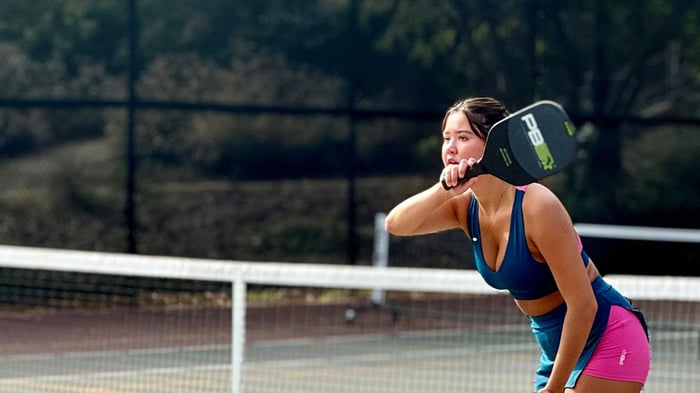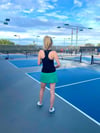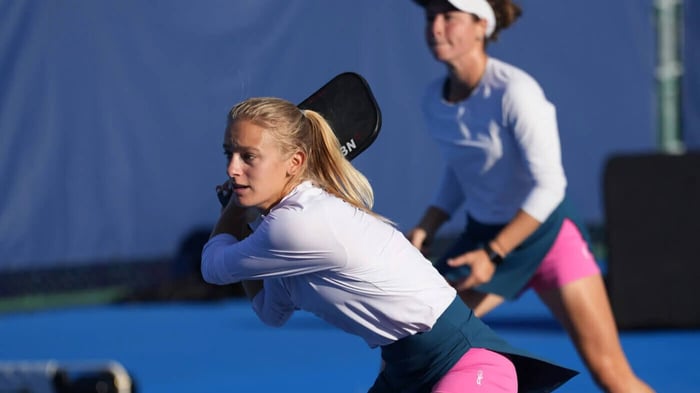Key takeaways:
Start with a solid stance, grip, and footwork—these basics make your backhand consistent and set you up for advanced techniques.
Use targeted drills like wall rallies, partner dinks, and figure-eights to build muscle memory that kicks in during real games.
Mix in two-handed backhands and slices so you’ve got smart options for different game situations.
A solid backhand can change the rhythm of a pickleball match. One moment you're defending, and the next, you're placing a clean winner that turns the rally in your favor. This shot expands what you can do strategically on the court, giving you more options in every rally. When you feel equally confident with forehand and backhand shots, you'll easily handle whatever comes at you.
This guide is here to help players of all levels build a more consistent backhand. As your backhand gets stronger, you’ll spend less time worrying about form and more time thinking ahead—setting up points, staying a step ahead, and enjoying the game on a whole new level. If you're looking to level up your gear along with your game, check out our selection of pickleball equipment at PB5star.
Master backhand basics
Stance, grip, and footwork support your backhand and shape how it feels in motion. When each part is working together, the shot comes off your paddle cleaner, quicker, and with less effort.
Perfect your stance
Your stance creates the foundation for every backhand shot. Keep your feet about shoulder-width apart in a position that lets you move quickly. Lowering your center of gravity, almost like you're half-sitting, might initially feel strange. Still, it gives you the stability needed for consistent returns.
Find your ideal grip
Your grip shapes how your backhand feels and responds. There are a few solid options worth trying out:
Continental grip: Feels like a handshake and works well for all kinds of shots. It’s simple, versatile, and a great starting point for most players.
Eastern backhand grip: Turn your hand slightly further behind the handle to add more topspin and control. It’s a nice upgrade if you want to shape your shots a bit more.
Two-handed grip: If you’re after extra stability and power, adding a second hand can make a big difference, especially on deeper backhands.
Try each one during your next few practice sessions and see what clicks. A paddle with a good mix of power and control, like PB5star’s Balance Paddle, works comfortably with any of these styles.
Master your footwork
Footwork can make or break your backhand game. Taking small, quick steps as you move toward the ball gives you much better control than lunging. Moving light on your feet rather than with heavy steps creates better positioning. This might seem like a small detail, but improving your footwork instantly upgrades your backhand effectiveness. Comfortable footwear like PB5 Court2 shoes helps support these quick movements on the court.
The building blocks of a great backhand make everything else click into place. Your stance, grip, and footwork are essential for consistent performance. Starting with these fundamentals accelerates your progress in more advanced techniques.
Build advanced backhand skills
Your backhand can reach new levels with these power moves and specialty shots. Once you add these techniques to your toolkit, you'll have options for any situation on the court. These advanced skills add versatility to your game and make playing even more enjoyable.
Two-handed backhand
If you want to add some serious oomph to your game, a two-handed backhand delivers that perfect mix of power and control. This technique turns ordinary returns into shots that make opponents take a step back.
Just stand with your feet shoulder-width apart, get your core into the rotation, and let both hands work together guiding the paddle through a smooth motion. Keeping your form consistent is what makes the magic happen. Once you've got the basics down, you'll place shots precisely while adding that extra zip that keeps you in control of the point.
Backhand slice
The backhand slice needs some technique tweaking to get right. Turn your body sideways to the net, keep those knees slightly bent, and angle your paddle face up about 45 degrees when you make contact. The secret is in the follow-through - brush right under the ball with a smooth, forward-to-back motion. This creates that fantastic low skid that often gets you a weak return to pounce on.
Your signature style
Everyone has their own flair on the court. Your unique style develops naturally as you mix power shots with crafty slices. You'll determine which combinations click for your game as you get more comfortable with different backhand techniques. Playing with others is great for improvement - they'll catch little form issues you might miss, and watching different playing styles can inspire new approaches to try yourself.
Each player favors different advanced techniques based on their natural style and physical strengths. Experiment with all these shots, then focus on perfecting the ones that complement your overall game the best.
Practice backhand effectively
Now that you know how to hit a backhand in pickleball, it's time to master your skills. These focused drills target specific aspects of your technique, helping you build muscle memory that kicks in automatically during fast-paced games.
Wall rallies
Stand about 10 feet from a wall for solo practice
Keep your paddle face steady as you hit the ball
Hold your paddle with a relaxed grip
Start with gentle hits, then gradually add more power
Practice for about 15 minutes to build consistency
Partner dinks
Stand at the kitchen line with a practice partner
Hit soft backhand shots back and forth over the net
Try to place your shots in different spots on the court
Focus on control rather than power
Practice feeling the ball on your paddle for better touch
Dynamic figure-eights
Move in a figure-8 pattern around the court
Switch between forehand and backhand shots as you move
Start slow and speed up as you get comfortable
Focus on footwork coordination with paddle movement
This helps you get better at moving during real games
Power play practice
Hit two-handed backhand shots against a wall
Start soft and gradually hit harder
Keep your shots controlled even as you add power
Use your core (stomach muscles) to generate power
This builds the muscle memory for strong returns
Target challenge
Put some targets on the court (water bottles work well)
Try to hit the targets with your backhand shots
Keep score to make it more fun
Practice with a friend for some friendly competition
Work on accuracy first, then add power later
Consistency with these drills translates directly to confidence on the court. Even short practice sessions create improvements you'll feel in your very next game.
Fix common backhand mistakes
Players at all levels develop habits that can limit their potential. Spotting and fixing these common backhand problems can quickly improve your game without requiring massive technique changes. The fastest improvements come from identifying and addressing these fundamental issues.
Death grip syndrome
During intense points, you might unconsciously strangle your paddle. This hidden tension turns smooth motions into stiff, robotic movements—regardless of which grip style you've chosen.
Quick fix: Between points, consciously shake out your hand and reset. This simple habit instantly restores natural motion to your backhand swing without changing your basic technique.
Out-of-position problems
Bad positioning leads to those awkward, off-balance backhand shots. You'll know you have this problem if you constantly stretch for balls or hit them too close to your body.
Key Improvement: Watch your opponent's paddle face and start moving before they even hit the ball. These early adjustment steps put you in the sweet spot for smooth, controlled returns.
Forehand dependency
Favoring your forehand makes you too predictable on the court. You might circle around backhand shots to use your stronger side, but savvy players will spot and exploit this pattern quickly.
Practice strategy: Force yourself to use your backhand during friendly games, even when you could reach for a forehand. It initially feels uncomfortable, but it builds real confidence when points matter.
Incomplete follow-through
Stopping your swing too early causes those frustrating backhand shots that go everywhere except where you aimed. The telltale sign is your paddle freezing right after hitting the ball.
Technique check: Have a friend film your practice. This common flaw is hard to feel but easy to see on video. Focusing on a full, complete swing can transform your backhand almost overnight.
Simple fixes often create the biggest improvements. Keeping an eye out for these common issues helps maintain your backhand quality without overthinking your technique.
Beyond the backhand
Your backhand is uniquely yours. Some players develop wicked slices, while others become known for powerful two-handed drives. What matters is finding what works for your body and play style and refining it consistently. The practice drills, technique adjustments, and common fixes in this guide provide a roadmap, but your path to backhand mastery will have distinct milestones and breakthroughs.
The ultimate reward isn't just a better backhand—it's the ability to play with complete confidence, focusing on the joy of the game rather than worrying about technique. When your backhand feels as natural as your forehand, you'll instinctively make the right shot choices, create better angles, and discover new ways to outmaneuver opponents. This is when pickleball becomes your game, shaped by your unique abilities and expressed through your personal playstyle.
To support your progress on the court, check out the latest gear at PB5star. From paddles designed for precision to apparel that boost comfort, you'll find everything you need to keep evolving your game.







